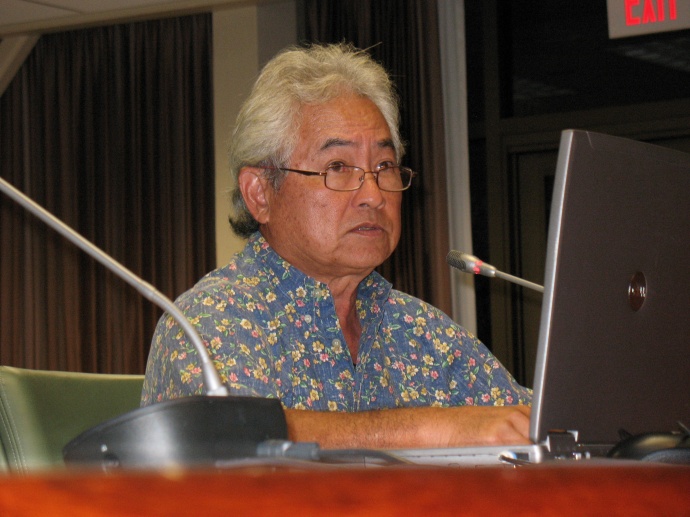Posted on September 5th, 2012
by Dave Smith
A County Council resolution urging Hawaii Electric Light Co. to seek lower power costs from renewable energy providers — hopefully to be passed on to consumers — brought out enthusiastic supporters today.
The measure introduced by Hilo Councilman J Yoshimoto asks HELCO to renegotiate its contracts with independent power producers to “de-link” the power from avoided cost, or what it would have cost to generate the power with fossil fuels.
The concept of avoided cost was established by the Public Utility Regulatory Policies Act of 1978 as an incentive for development of sources of renewable energy. The federal law contained a provision that states could opt out of the program, which Hawaii did in 2006.
Currently, only 13 megawatts of the renewable-source electricity HELCO buys is not tied to avoided cost. That includes a contract recently established for an 8-megawatt expansion of Puna Geothermal Venture and a renegotiated price for 5 megawatts of the 30 megawatts already being provided by PGV.
HELCO President Jay Ignacio responds to questions about the utility’s electrical rates. Photo by Dave Smith.
HELCO has declined to reveal its specific power costs, but the company’s president, Jay Ignacio, told Big Island Now that the impact on residential power bills from the new contracts would be negligible.
According to Yoshimoto’s resolution, which passed unanimously, HELCO estimates that PGV’s 8-megawatt expansion under the lowered cost will reduce a typical residential electricity bill by $1.67 in 2015.
Earlier this year HELCO officials signed another de-linked contract, this one with Hu Honua Bioenergy to provide 21.5 megawatts to be generated by the burning of biomass at the former Hilo Coast Processing Co. sugar mill in Pepeekeo. Hu Honua isn’t expected to begin producing power until 2014 at the earliest.
During a meeting of the council’s Committee on Agriculture, Water & Energy Sustainability that ran well into the night, all of the testimony was in support of Yoshimoto’s resolution, although most of those speaking said it did not go far enough.
Kuulei Cooper of Pohoiki testified that the resolution would be “only a suggestion” and didn’t go far enough to break what she called HELCO’s “egregious monopoly.”
Wallace Ishibashi, a negotiator for the International Longshore and Warehouse Union, told council members that electricity prices must come down. He said it affects workers because their employers pay so much for power.
HELCO’s residential rates, currently about 43 cents per kilowatt hour, are often the highest in the nation.
“This is too much,” Ishibashi said. “They’re not going to take it anymore.”
Mililani Trask, a principal in Indigenous Consultants, an organization seeking to develop geothermal energy sources to benefit indigenous peoples, described the previous contract between Hawaiian Electric Co. and Ormat Technologies, owner of PGV, as “price-fixing.”
Trask suggested requiring that the resolution be amended to require that HELCO report back on its efforts to renegotiate contracts.
Yoshimoto later noted that while the Public Utilities Commission approved the 8-megawatt and 5-megawatt deals, it criticized HELCO and PGV for failing to extend the de-linking to the remaining 25 megawatts.
He said the PUC seemed resigned to the result, but the public need not be, and he hoped his resolution would encourage it to speak out.
“I think change starts with the people,” he said.
Yoshimoto noted that rates are established by contracts over which the council has no power. But, he said, just because the companies can make their own deals, that “doesn’t make it right.”
Yoshimoto’s resolution notes that HELCO contracts with three other companies providing power from wind and hydroelectric facilities remain based on avoided costs.
Councilwoman Brenda Ford expressed doubt that reducing the cost of power to HELCO would translate into much in the way of lower consumer bills.
Independent producers using both renewable resources and oil currently produce about 130 megawatts to HELCO, representing a little under half of the utility’s total power capacity.
HELCO President Jay Ignacio told council members that his company doesn’t make any profit from independent power producers. He said HELCO makes profits on its investments including utility infrastructure.
Ignacio said he is agreement with the resolution and his company has already attempted to renegotiate existing contracts. He said HELCO is currently in talks with PGV at that company’s request.
“That’s good news,” Yoshimoto said. He asked if any details could be provided, but Ignacio said the process has to be confidential.
Ignacio said the existing contract with PGV for the remaining 25 megawatts expires in 2027, and existing contracts with other renewable energy producers run for either 20 or 30 years.
In addition to the roughly 40 megawatts that HELCO obtains from geothermal, wind and hydroelectric power, the utility receives about 17 megawatts in solar power, most from homes or businesses that use net metering to reduce their individual energy bills.
Ignacio said HELCO’s efforts to obtain power from producers such as Hu Honua, as well as its current plan to obtain another 50 megawatts from geothermal, is designed to reduce HELCO’s dependence on oil and its volatile pricing. Increases in the price of oil can raise electricity bills through PUC-approved surcharges.
“If we can drive that down, that will really help our customers out,” he said.
Council Chairman Dominic Yagong successfully introduced an amendment to the resolution similar to Trask’s suggestion which asked that HELCO appear before the council at its Oct. 17 meeting to report on its progress in renegotiating with PGV.
Ignacio said his company would be willing to provide the update, but would still have to maintain confidentiality.
“I’m not sure what we can share with you,” he said. He also noted that the recent 8-megawatt contract took three years to negotiate.
Any contract changes must be approved by the PUC.
HELCO recently asked the PUC to approve a 4.2% rate increase it says is needed to pay for a variety of renewable energy projects including forecasting systems for wind and computerized models to analyze the addition of more solar power into its grid.
If approved, the hike would add $8.32 to a typical 500 kilowatt-hour monthly electric bill.





